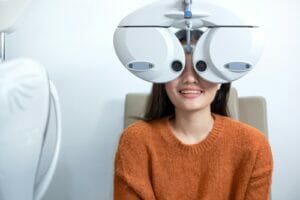Out-of-pocket medical expenses can add up. Even if you have good medical and vision insurance, anyone who relies on glasses and contacts can expect to spend a significant amount of money on eye care every year.
But if your employer offers an HSA or FSA, you can more easily pay for routine and surprise expenses. FSAs can be a little trickier since the funds don’t roll over, but you still have time to use whatever money you’ve set aside this year on all kinds of eye care needs! Keep reading to learn how to use your FSA on eye care this year!
FSA vs. HSA
HSAs, Health Savings Accounts, and FSAs, Flexible Savings Accounts, are both funds you contribute out of your paycheck to use for various medical expenses. But the money you put in is your pre-tax earnings, making it easier to save up more money for these out-of-pocket medical expenses.

Employers often offer HSAs or FSAs in addition to the insurance plan they provide you with to help you manage extra costs associated with any medical needs you have throughout the year. The main difference between an HSA and an FSA is the money you put in an HSA throughout the year stays in the account even after the tax year ends.
Money in an FSA doesn’t roll over. Once the year ends, your FSA funds will expire, leaving you very little time to spend what you have before the tax year is over.
If you don’t, you’ll lose what you’ve saved. Some FSAs do give a little leeway, allowing you to use the money within the first few months of the new year, but some plans have a hard December 31st cutoff.
It is important to note that new legislation signed into law in late 2020 allows funds from an FSA to roll over any used funds from 2021 to 2022. The funds can be used at any time in 2022, but there’s a catch. Your employer must adopt the provision for it to be available to you.
Even if you can use your FSA funds into the new year, this depends on your employer. The good news is that even if you have a hard cutoff and get to December with money still left in your FSA that you want to use, there’s plenty you can use it for just for eyecare alone.
Eye Care Costs
Eyecare costs are usually covered by insurance, but there are plenty of out-of-pocket expenses. Sometimes you’ll be charged for visits to the eye doctor, and you’ll almost certainly have to pay at least some of the cost of new glasses or contacts out-of-pocket.

Your insurance also probably only covers a certain amount of contact lenses or new frames for your glasses per year. That means that you’ll be out of luck if you lose either some contacts or a pair of glasses and need replacements.
Or, if you want a backup pair of glasses just in case or want to switch up your look, you aren’t left with many options beyond paying out of pocket. It’s situations like these where having an FSA can come in handy.
If you’ve put off your yearly eye exam because you’re worried about having to pay extra for the appointment or new frames for your prescription, this is a perfect time to go in and spend your FSA funds. You may be able to get more than one pair of glasses or upgrade your contacts.
If you’re sick of glasses and contacts altogether, there’s another great way to use your FSA savings. Choosing a vision correction procedure can save you money while providing you with the crystal-clear vision you’ve always dreamed of.
Vision Correction Surgery

The great thing about FSAs is you can use the money for elective procedures. An elective procedure like clear lens exchange is included in this.
Even if you don’t have enough in your FSA to cover the total cost of clear lens exchange, you can pay for a significant amount of it. Then, you can finance the rest with an affordable, zero-interest payment plan.
A clear lens exchange is an excellent option if you want to correct your vision and not have to worry about cataracts later on. Talk to your eye doctor to determine which vision correction procedure may be the best fit for your lifestyle and visual needs.
Premium IOLs for Cataract Surgery
Do you have cataracts? Have you been putting off getting cataract surgery, even though you’re struggling with everyday tasks because of impaired vision? Now is the perfect time to finally get cataract surgery.

While cataract surgery is covered by insurance since it’s considered medically necessary to reverse or prevent blindness from cataracts, insurance usually only covers standard IOLs. An IOL, or intraocular lens, is the artificial lens that replaces your eye’s natural lens when it’s removed during cataract surgery.
IOLs come in many varieties, with some correcting your vision to the point that you can reduce your dependence on glasses and contact lenses after cataract surgery. Others can correct presbyopia while removing cataracts at the same time.
If you want the most out of cataract surgery, you should consider a premium IOL. These IOLs can give you an expansive visual range and eliminate the need for reading and regular glasses.
They’re also an out-of-pocket expense, which means you can cover the cost with money from your FSA! Using your funds to get a premium IOL is excellent motivation to finally schedule having cataract surgery before the end of the year.
Don’t wait! Use your FSA funds before they expire at the end of the year on the eyecare services you need or want the most. Schedule an appointment at Sierra Nevada Eye Center in Carson City, NV, to learn more and make the most of your FSA!


